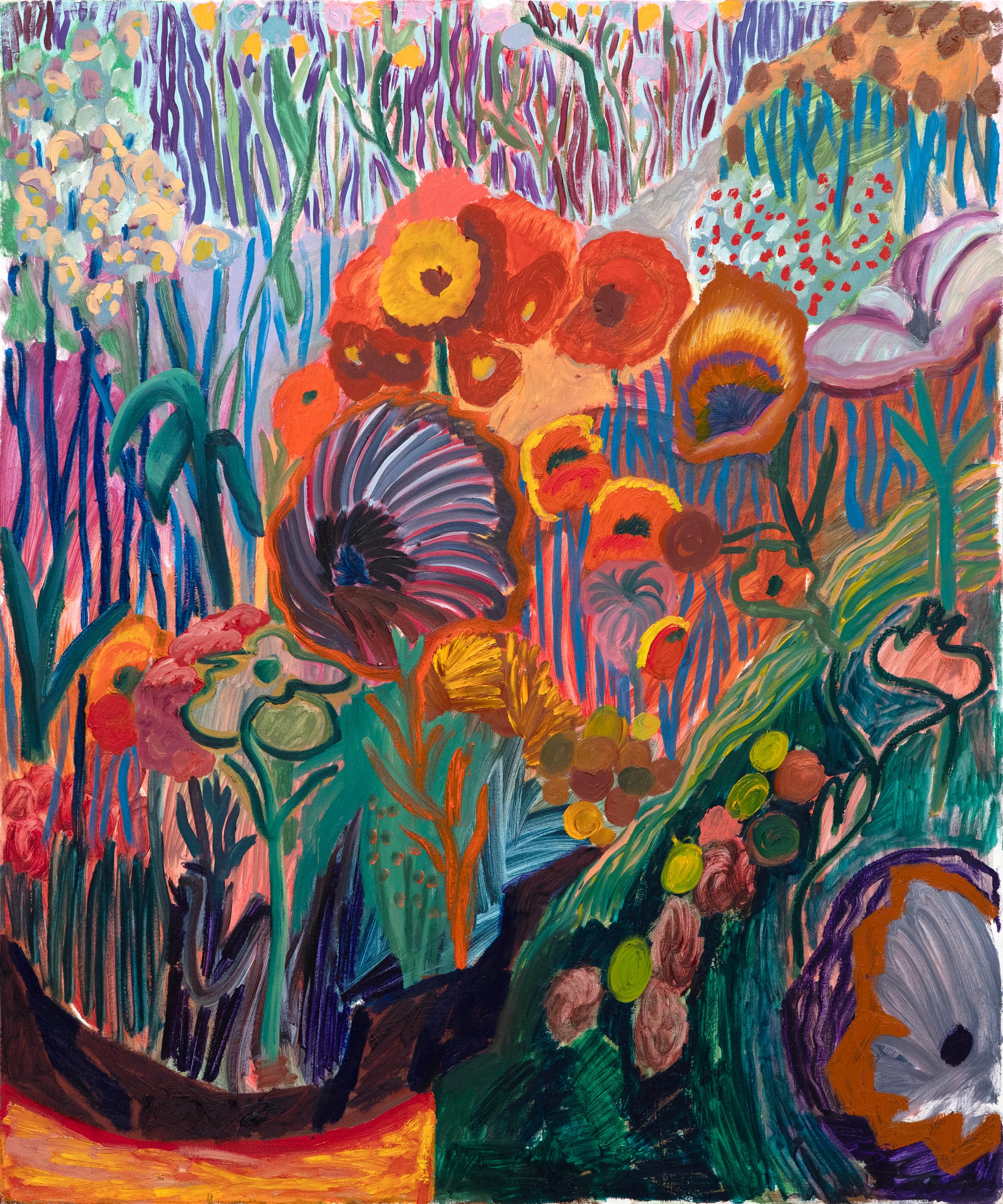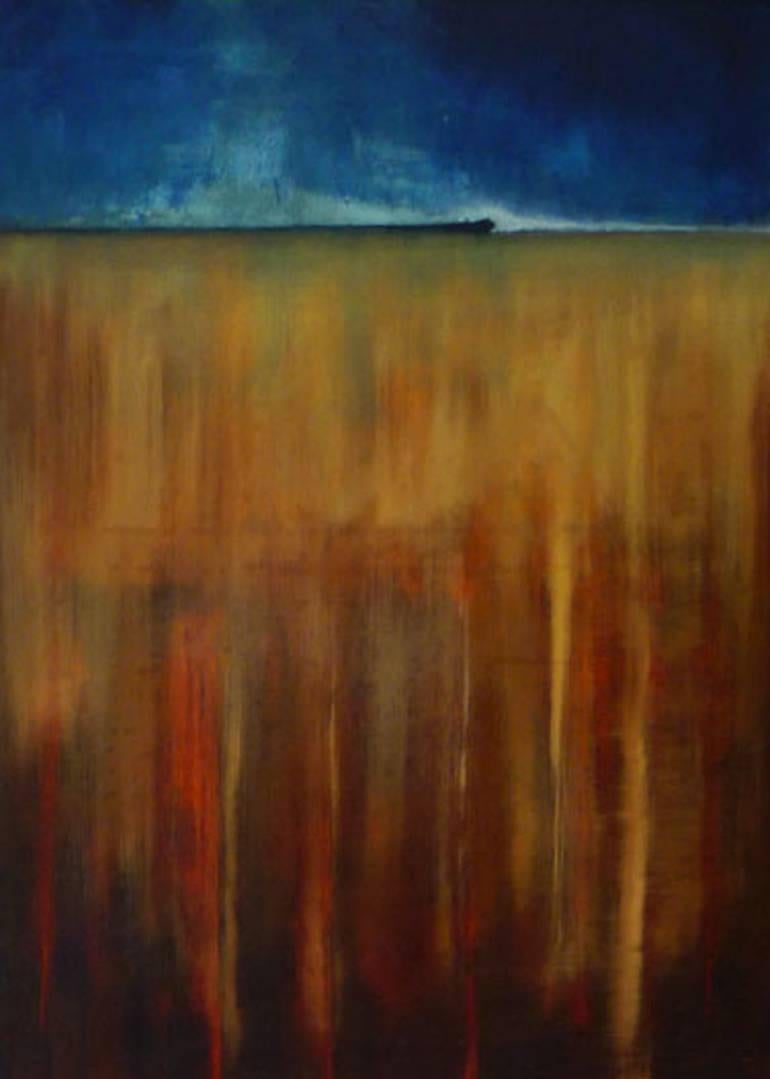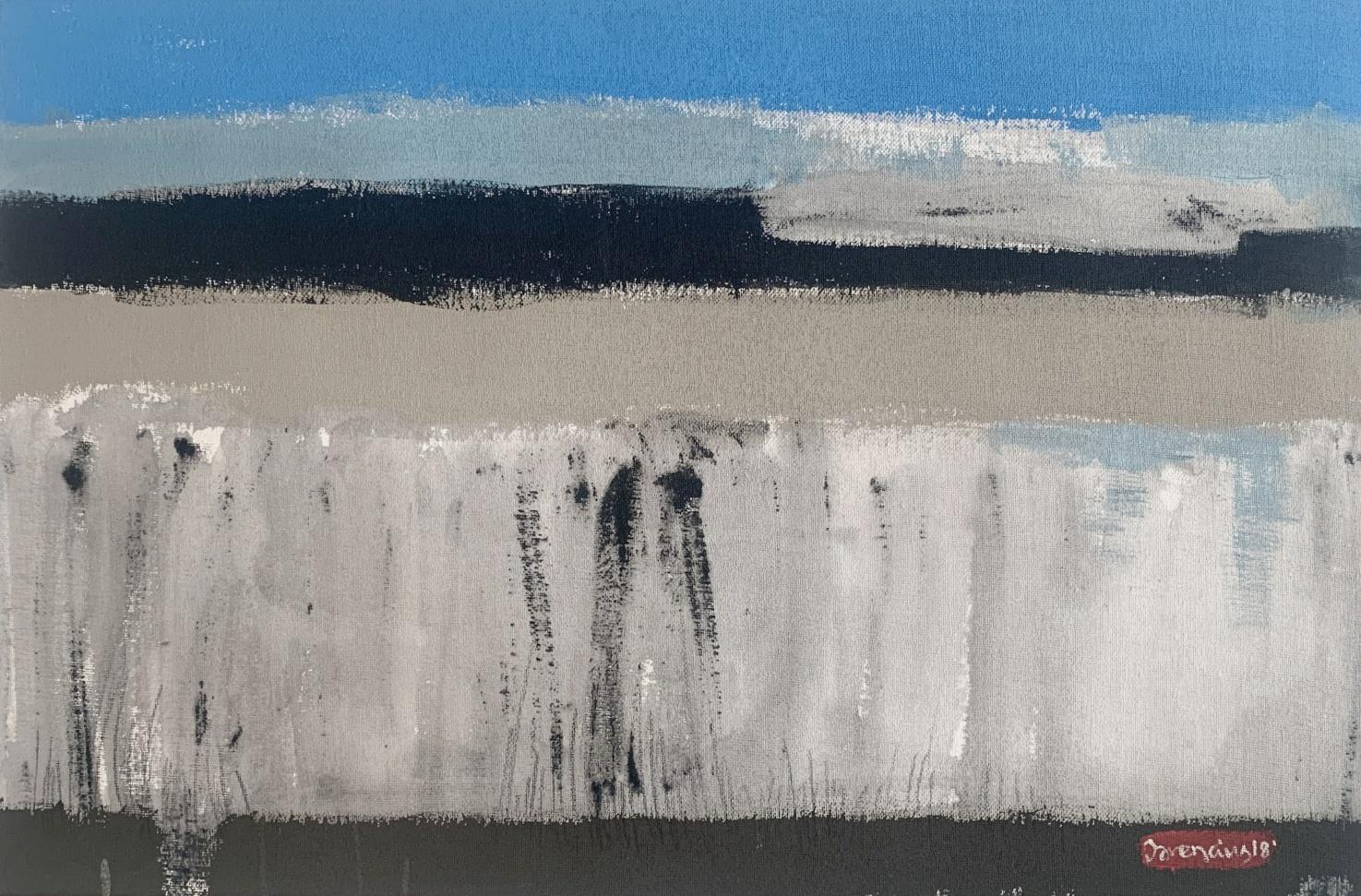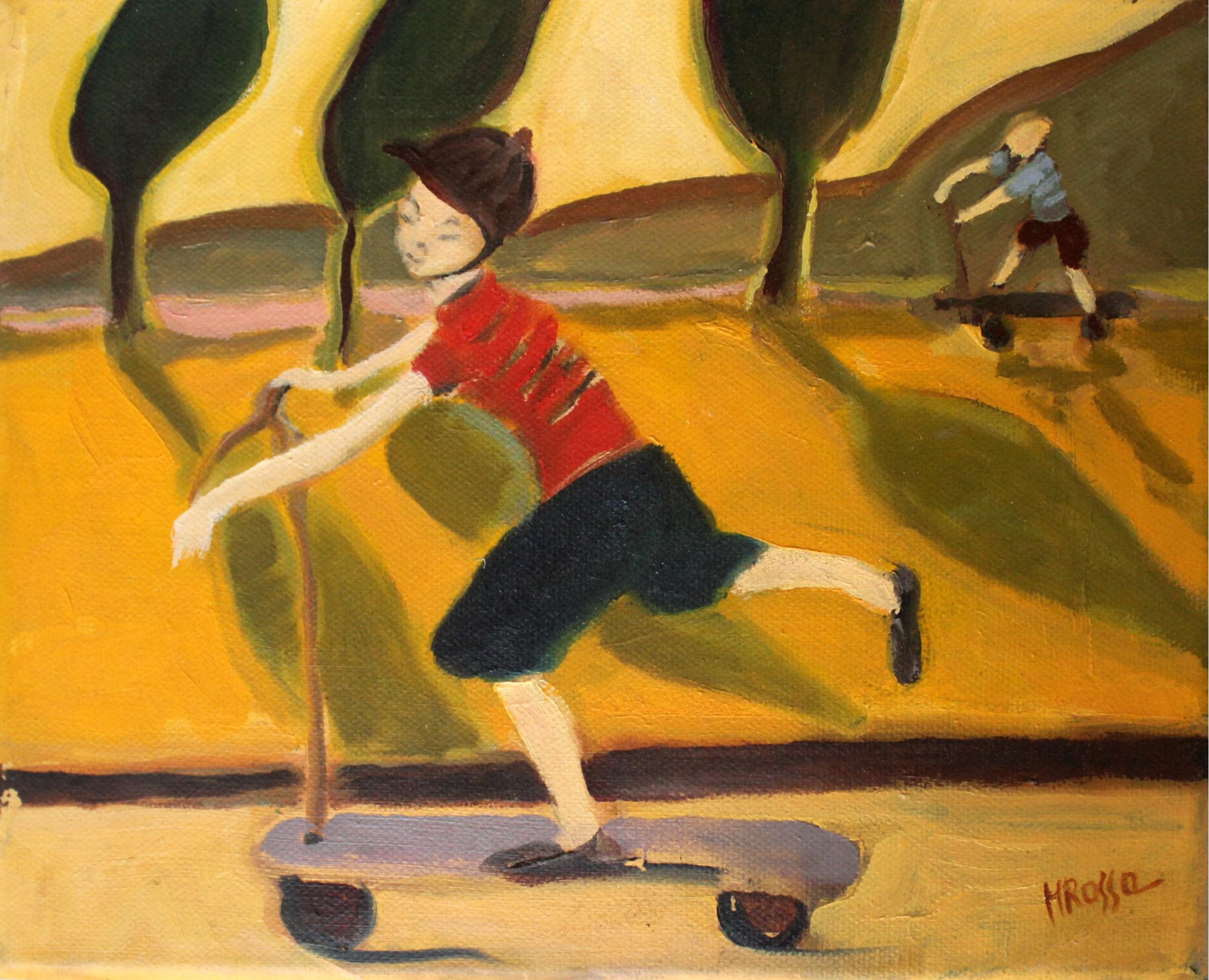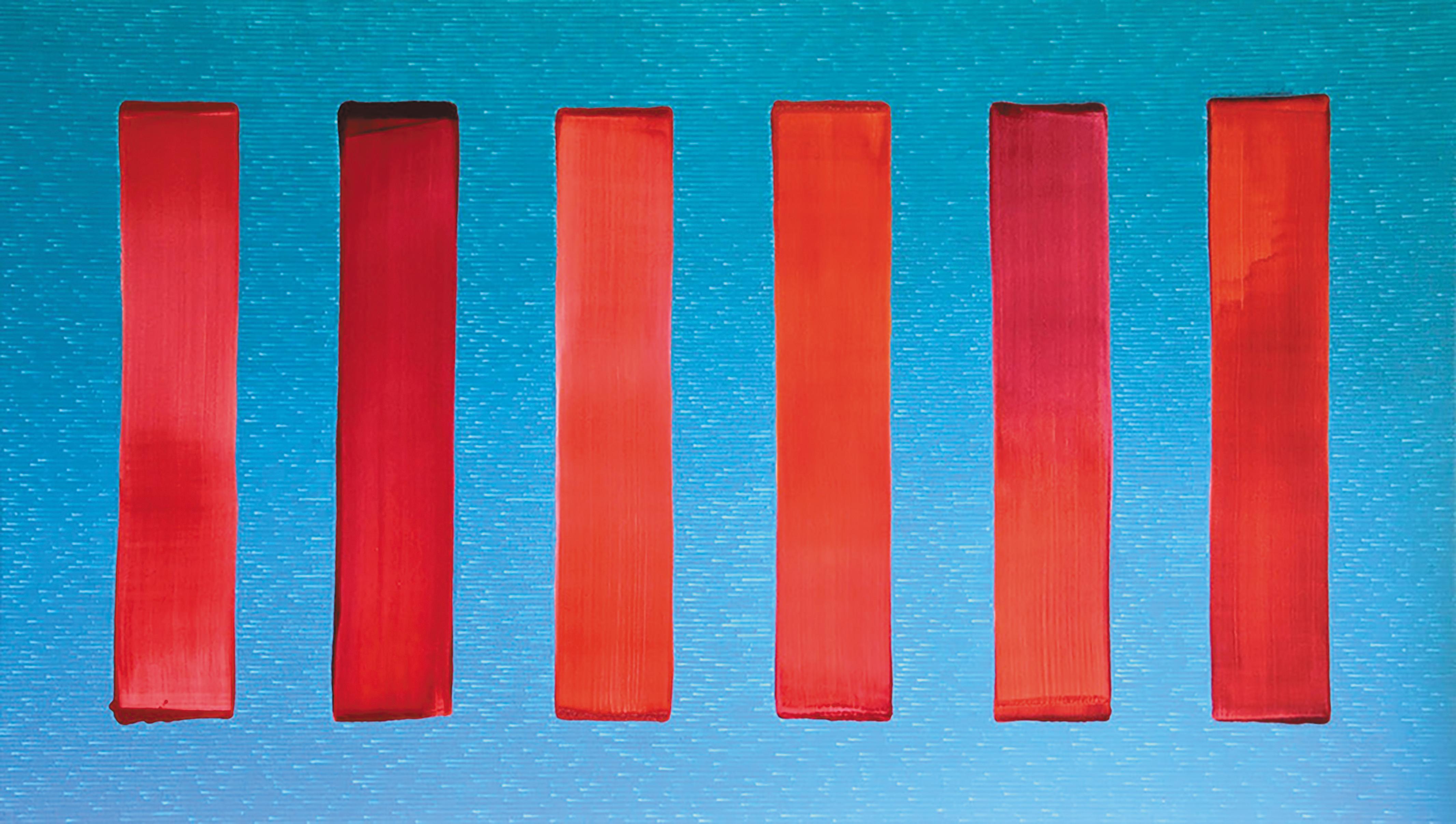Items Similar to Large Plein Air Landscape Oil Painting, Peach & Plenty, Hamptons, Janet Jennings
Want more images or videos?
Request additional images or videos from the seller
Janet JenningsLarge Plein Air Landscape Oil Painting, Peach & Plenty, Hamptons, Janet Jennings1989
1989
About the Item
Janet Jennings
Oil Painting on Canvas
Peace and Plenty, 1989.
Hand signed
Dimensions: Canvas, 65 1/2" x W: 59 1/2". framed 68 X 62 inches
Janet Jennings received her BFA from the University of Dayton and attended The Dayton Art Institute, Antioch College and The Art Students League. Her paintings are in numerous corporate and private collections worldwide.
She has exhibited at numerous galleries on Long Island, the Hamptons and New York City including The New York Design Center, Hampton Road Gallery, Pamela Williams Gallery, Folioeast, Lizan-Tops Gallery, Chase Edwards Gallery, Gallery North, Elaine Benson Gallery, Glenn Horowitz Gallery, Mark Humphrey Gallery, and Arc Fine Arts.
Janet Jennings is known for her luminous oil & watercolor paintings.
After working for Lawrence Rubin at Knoedler Contemporary Art, Jennings maintained a studio at Waverly Studios in New York City. She began as a Color Field abstract painter, working on canvas and linen. Later moving to works inspired by the ocean, the landscape, the light and the countryside. Janet moved to Amagansett, NY in 1981 and switched her focus to figurative landscape painting. She later moved back to color study paintings which drew from the lessons of Josef Albers, Ellsworth Kelly and Johannes Itten. She taught at The Parrish Art Museum, Guild Hall & The Victor D’amico Institute of Art. From 1993 to 1998, she was the Chair of the Andy Warhol Visual Arts Preserve Program.
Select Exhibitions
Elaine Benson Gallery
Schoelkopf Gallery: Summer show with Gary Komarin, Massimo Vitali, Sam Francis & Donald Baechler
Arc Fine art Selection: Alex Katz, Hunt Slonem, Olivia Munroe, Chris Leidy & Laura McPhee
Peter Marcelle Gallery, Bridgehampton, New York
Pamela Williams Gallery, Amagansett, New York
- Creator:
- Creation Year:1989
- Dimensions:Height: 68 in (172.72 cm)Width: 62 in (157.48 cm)
- Medium:
- Movement & Style:
- Period:
- Condition:
- Gallery Location:Surfside, FL
- Reference Number:1stDibs: LU38211534072
About the Seller
4.9
Platinum Seller
These expertly vetted sellers are 1stDibs' most experienced sellers and are rated highest by our customers.
Established in 1995
1stDibs seller since 2014
1,553 sales on 1stDibs
Typical response time: 1 hour
- ShippingRetrieving quote...Ships From: Surfside, FL
- Return PolicyA return for this item may be initiated within 3 days of delivery.
More From This SellerView All
- Modernist Oil Painting Moody Fauvist Abstract Nude Figure Ralph Della VolpeLocated in Surfside, FLRALPH DELLA-VOLPE (1923-2017) Fine Art Painter, American Contemporary Oil on canvas Hand signed lower right Artist Signed, Abstract Oil on Canvas. Figure in the distance. Approx: 30" x 27 1/2" framed, 26 1/2" x 23 1/2" canvas. TRAINING: National Academy of Design The Art Students League, NYC Ralph Eugene Della-Volpe's semi-abstract paintings of often simplified, minimalist, beach scenes and anonymous portraits "convey profound awareness of mood and character", and his paintings are hardly as literal as they may first appear (Arts Magazine. "New York Exhibitions". 1965). His brightly-colored, light-infused, ornamental compositions bring together aspects of many modernist art movements including Fauvism, Impressionism, Symbolism, and abstraction. Della-Volpe first studied painting at the prestigious National Academy of Design before joining the Army during World War II. As a soldier, the artist saw action on Utah Beach, winning a Purple Heart, and his experiences undoubtedly affected his later artistic style. The Fauvist "coloristic exuberance" found in the works beginning in the mid 1960's, with their vibrant fuschias and yellows, seem to offset what could be an otherwise solemn tone to many of his works at the time. Upon his return from military service, Della-Volpe’s style evolved significantly. In the years following the second world war, his work was solemn, imbued with a quiet darkness. Over time, this darkness faded: by the 1950s, influenced by his time at the Art Students League, his oeuvre was overtaken by the tenants of Abstract Expressionism. Paintings from this period boast bold brushwork, energetic compositions, and strong color. Although the next decade saw Della-Volpe trade expressionist abstraction for figuration, his love of color continued to shine through his work.Della-Volpe took a teaching position as the first artist-in-residence at Bennett College in Millbrook, New York where he remained for 28 years, serving as chairman of the Art Department for most of that time. Obviously influenced by impressionism 's preoccupation with the treatment of light, Della-Volpe's own works have a "faultless tonal quality, with its sense of failing light—the areas of silvery gray deepening into rosy tans" (Arts Magazine. "In the Galleries". 1960). Della-Volpe has exhibited widely throughout his career and has lectured on art at colleges, universities, and galleries across the country. He was included in the show Abstraction: 1950-1970 at Taylor Graham, Greenwich CT. A survey of post-war abstract art movements including Abstract Expressionism, Color Field, Hard Edge, Minimalism and Op-Art. Adolph Gottlieb, André Cottavoz, Carl Robert Holty, Cleve Gray, Friedel Dzubas, Ilya Bolotowsky, James Hiroshi Suzuki, Norman Bluhm, Ralph Della-Volpe, Theodore Appleby...Category
20th Century Fauvist Abstract Paintings
MaterialsCanvas, Oil
- American Vivid Abstract Expressionist Art Oil Painting Norman Carton, WPA ArtistBy Norman CartonLocated in Surfside, FLNorman Carton (1908 – 1980) was an American artist and educator known for abstract expressionist art. He was born in the Ukraine region of Imperial Russia and moved to the United States in 1922 where he spent most of his adult life. A classically trained portrait and landscape artist, Carton also worked as a drafter, newspaper illustrator, muralist, theater set designer, photographer, and fabric designer and spent most of his mature life as an art educator. Carton showed in and continues to be shown in many solo and group exhibitions. His work is included in numerous museums and private collections throughout the world. Norman Carton was born in the Dnieper Ukraine territory of the Russian Empire in 1908. Escaping the turbulence of civil war massacres, he settled in Philadelphia in 1922 after years of constant flight. While attending the Pennsylvania Museum School of Industrial Art, Carton worked as a newspaper artist for the Philadelphia Record from 1928 to 1930 in the company of other illustrator/artists who had founded the Ashcan School, the beginnings of modern American art. From 1930 to 1935, he studied at the Pennsylvania Academy of Fine Arts under Henry McCarter, who was a pupil of Toulouse-Lautrec, Puvis de Chavanne, and Thomas Eakins. Arthur Carles, especially with his sense of color, and the architect John Harbison also provided tutelage and inspiration. Following his time at the Pennsylvania Academy of Fine Arts, Carton studied at the Barnes Foundation from 1935 to 1936 where he was influenced by an intellectual climate led by visiting lecturers John Dewey and Bertrand Russell as well as daily access to Albert C. Barnes and his art collection. Carton was awarded the Cresson Traveling Scholarship in 1934 which allowed him to travel through Europe and study in Paris. There he expanded his artistic horizons with influences stemming from Henri Matisse, Pablo Picasso, Chaim Soutine, and Wassily Kandinsky. While at the Pennsylvania Academy of Fine Arts, Carton was also awarded the Toppan Prize for figure painting as well as the Thouron Composition Prize. He received numerous commissions as a portrait artist, social realist, sculptor, and theatrical stage designer as well as academic scholarships. During this time, Carton worked as a scenery designer at Sparks Scenic Studios, a drafter at the Philadelphia Enameling Works, and a fine art lithographer. From 1939 to 1942, the Works Progress Administration (WPA) Federal Art Project employed Carton as a muralist and easel artist. He collaborated with architect George Howe. The WPA commissioned Carton to paint major murals at the Helen Fleischer Vocational School for Girls in Philadelphia, the Officers’ Club at Camp Meade Army Base in Maryland, and in the city of Hidalgo, Mexico. Throughout the 1940s, Carton exhibited and won prizes for his semi-abstract Expressionist and Surrealist paintings. He socialized with and was inspired by Émile Gauguin and Fernand Leger. During World War II, Carton was a naval structural designer and draftsman at the Cramps...Category
Mid-20th Century Abstract Expressionist Landscape Paintings
MaterialsCanvas, Oil
- American Vivid Abstract Expressionist Art Oil Painting Norman Carton, WPA ArtistBy Norman CartonLocated in Surfside, FLNorman Carton (1908 – 1980) was an American artist and educator known for abstract expressionist art. He was born in the Ukraine region of Imperial Russia and moved to the United States in 1922 where he spent most of his adult life. A classically trained portrait and landscape artist, Carton also worked as a drafter, newspaper illustrator, muralist, theater set designer, photographer, and fabric designer and spent most of his mature life as an art educator. Carton showed in and continues to be shown in many solo and group exhibitions. His work is included in numerous museums and private collections throughout the world. Norman Carton was born in the Dnieper Ukraine territory of the Russian Empire in 1908. Escaping the turbulence of civil war massacres, he settled in Philadelphia in 1922 after years of constant flight. While attending the Pennsylvania Museum School of Industrial Art, Carton worked as a newspaper artist for the Philadelphia Record from 1928 to 1930 in the company of other illustrator/artists who had founded the Ashcan School, the beginnings of modern American art. From 1930 to 1935, he studied at the Pennsylvania Academy of Fine Arts under Henry McCarter, who was a pupil of Toulouse-Lautrec, Puvis de Chavanne, and Thomas Eakins. Arthur Carles, especially with his sense of color, and the architect John Harbison also provided tutelage and inspiration. Following his time at the Pennsylvania Academy of Fine Arts, Carton studied at the Barnes Foundation from 1935 to 1936 where he was influenced by an intellectual climate led by visiting lecturers John Dewey and Bertrand Russell as well as daily access to Albert C. Barnes and his art collection. Carton was awarded the Cresson Traveling Scholarship in 1934 which allowed him to travel through Europe and study in Paris. There he expanded his artistic horizons with influences stemming from Henri Matisse, Pablo Picasso, Chaim Soutine, and Wassily Kandinsky. While at the Pennsylvania Academy of Fine Arts, Carton was also awarded the Toppan Prize for figure painting as well as the Thouron Composition Prize. He received numerous commissions as a portrait artist, social realist, sculptor, and theatrical stage designer as well as academic scholarships. During this time, Carton worked as a scenery designer at Sparks Scenic Studios, a drafter at the Philadelphia Enameling Works, and a fine art lithographer. From 1939 to 1942, the Works Progress Administration (WPA) Federal Art Project employed Carton as a muralist and easel artist. He collaborated with architect George Howe. The WPA commissioned Carton to paint major murals at the Helen Fleischer Vocational School for Girls in Philadelphia, the Officers’ Club at Camp Meade Army Base in Maryland, and in the city of Hidalgo, Mexico. Throughout the 1940s, Carton exhibited and won prizes for his semi-abstract Expressionist and Surrealist paintings. He socialized with and was inspired by Émile Gauguin and Fernand Leger. During World War II, Carton was a naval structural designer and draftsman at the Cramps...Category
Mid-20th Century Abstract Expressionist Landscape Paintings
MaterialsCanvas, Oil
- Israeli Modernist Abstract Expressionist Seascape Oil Painting Tel Aviv HarborBy Motke BlumLocated in Surfside, FLIn this artwork the artist uses the medium spontaneously .The paint has been applied thickly to the surface. The resulting work emphasizes the physical act of painting itself as an essential aspect of the finished work or concern of the artist. size is with frame. Motke Blum was born in Racacun, Romania in 1925. Early in his childhood, the Blum family moved to Bukarest where they settled in a house situated near a circus. The circus would become young Blum's greatest love. He befriended several of the clowns and other performers and, when not painting or playing in clay, Blum could be found enjoyoing the company of these spirited entertainers. These experiences would later become a recurring theme in many of his works of art. In 1938, he was taken by the Romanian Iron Guard. When the Germans invaded Romania, Blum was taken to a forced labor camp. Even during his imprisonment, he continued to create art, painting on the walls of the camp. He escaped the camp in 1944 and boarded an immigrants' ship to Israel. One of the three ships in the convoy was sunk by a German torpedo. Motke later incorporated shipwrecks, boats, and other maritime subjects into several of his paintings. Over the course of his long and fruitful career, Blum showed internationally at over fifty one-man-shows with exhibits in Israel, Holland, England, Belgium, the United States, France, Australia, and more. His art has been commissioned for public buildings and by prominant figures in Israel and around the world, and a series of posters were commissioned by the Justice Ministry and the Ministry of Tourism. Giving back to the community has been a focus throughout his life. After establishing a studio at Chutzot Hayotzer, Motke welcomed schools and both adults and children with special needs, using painting...Category
Mid-20th Century Modern Abstract Paintings
MaterialsCanvas, Oil
- Israeli Modernist Abstract Expressionist Jerusalem Kotel Oil Painting JudaicaBy Efraim ModzelevichLocated in Surfside, FLEfraim Modzelevich (1931-1995) Work is abstract in subject, and expressive in terms of technique. The artist uses a muted color palette, and thick layers of paint to build up his co...Category
Mid-20th Century Modern Abstract Paintings
MaterialsCanvas, Oil
- Large Polish French Paris Scene Mid Century Modernist Oil Painting Moulin RougeBy Abram KrolLocated in Surfside, FLWonderful scene of the Moulin Rouge cabaret nightclub at Place Pigalle in Paris. Painted in wonderful moody blue and red colors. Size includes frame. Abram Abraham Krol was born January 22, 1919, in Pabianice (Lodz), Poland. Abram Krol went to France in 1938 to study civil engineering at the University of Caen. In 1939 at the beginning of World War II he joined the Foreign Legion. After he was demobilized, he became a mechanic in a garage in Avignon. Although Jewish, he survived the war with a false identity. In 1943, Krol started studying to be an artist, taking courses in sculpture at the city’s School of Fine Art. He also began studying painting and self-described himself as a “Sunday painter.” Krol moved to Paris in 1944. The first exhibition of his work was in 1946 in the Katia Granoff Gallery in Paris. After the war, Krol took up engraving, studying that art form with an engraver he met in Paris. Krol reflected his Hasidic childhood often using Biblical themes in his art works. He said, During all my years of childhood I had read the Bible endlessly. I came back to the Bible because I was on solid ground there. It was part of the assertion of my own truth after a time of complacency. It seemed to me that in painting or engraving there were so many reefs to avoid, so many possibilities of setback, that I had to have all the odds in my favor do what I could—say what I had to say. Krol illustrated over 20 literary works from the late 1940s through the 1960s. He also engraved medals for the Paris mint and painted murals for schools in France. He designed tapestries and painted approximately 200 enamels. Museums and libraries which own Krol’s art works include the Bibliotheque Nationale in Paris; the Victoria and Albert Museum in London; the British Museum; Houghton Library, Harvard; Bodleian Library, Oxford, and the Palace of the Legion of Honor in San Francisco. Krol has had numerous one-man shows throughout Europe, Brazil, and in California. In 1960, Krol was invited to the Venice Biennale. He was awarded the Critics Prize in 1958. He also won the Feneon Prize among other honors. Krol died on October 9, 2001. The School of Paris, Ecole de Paris, was not a single art movement or institution, but refers to the importance of Paris as a center of Western art in the early decades of the 20th century. Between 1900 and 1940 the city drew artists from all over the world and became a centre for artistic activity. School of Paris was used to describe this loose community, particularly of non-French artists, centered in the cafes, salons and shared workspaces and galleries of Montparnasse. Before World War I, a group of expatriates in Paris created art in the styles of Post-Impressionism, Cubism and Fauvism. The group included artists like Pablo Picasso, Marc Chagall, Amedeo Modigliani and Piet Mondrian. Associated French artists included Pierre Bonnard, Henri Matisse, Jean Metzinger and Albert Gleizes. The term "School of Paris" was used in 1925 by André Warnod to refer to the many foreign-born artists who had migrated to Paris. The term soon gained currency, often as a derogatory label by critics who saw the foreign artists—many of whom were Jewish—as a threat to the purity of French art. Art critic Louis Vauxcelles, noted for coining the terms "Fauvism" and "Cubism", Waldemar George, himself a French Jew, in 1931 lamented that the Ecole de paris, School of Paris name "allows any artist to pretend he is French. it refers to French tradition but instead annihilates it. The artists working in Paris between World War I and World War II experimented with various styles including Cubism, Orphism, Surrealism and Dada. Foreign and French artists working in Paris included Jean Arp, Joan Miro, Constantin Brancusi, Raoul Dufy, Tsuguharu Foujita, artists from Belarus like Michel Kikoine, Pinchus Kremegne, and Jacques Lipchitz, the Polish artist Marek Szwarc and others such as Russian-born prince Alexis Arapoff. A significant subset, the Jewish artists, came to be known as the Jewish School of Paris or the School of Montparnasse. The core members were almost all Jews, and the resentment expressed toward them by French critics in the 1930s was unquestionably fueled by anti-Semitism. Jewish members of the group included Emmanuel Mané-Katz, Chaim Soutine, Adolphe Féder...Category
1950s Modern Landscape Paintings
MaterialsCanvas, Oil
You May Also Like
- All The Pretty FacesLocated in Palm Desert, CA"All the Pretty Faces" is an oil on canvas painting made by Shara Hughes in 2019. The artwork size is 36 x 30 inches. The work is signed verso, "Shara Hug...Category
21st Century and Contemporary Contemporary Abstract Paintings
MaterialsCanvas, Oil
- Beach GrassBy Kristen GarneauLocated in Mill Valley, CAoil on canvas Kristen Garneau lives in Northern California and has spent a lifetime with the inspiration that comes from ever-changing beautiful landscape – forest, mountain and ocea...Category
2010s Contemporary Landscape Paintings
MaterialsCanvas, Oil
- Anchor-R - contemporary abstract framed portrait seascape oil on canvasBy Simon LedsonLocated in London, GBSimon Ledson is a surfer, artist and graphic designer whose work is an experiment that investigates the way the rhythm of the ocean connects with the artist’s body and charts the imp...Category
2010s Contemporary Abstract Paintings
MaterialsOil, Canvas
- The River 9 - Contemporary Abstract Landscape Oil Painting, Polish artLocated in Warsaw, PLOil on canvas on cardboard Painting by Polish artist Jaroslaw Romaniuk PROVENANCE Exhibited at Katarzyna Napiorkowska Gallery. The Gallery is a primary representative for this arti...Category
2010s Contemporary Abstract Paintings
MaterialsCanvas, Oil, Cardboard
- Scooter - XXI century, Contemporary Oil Painting, Bright Vibrant ColorsBy Monika RossaLocated in Warsaw, PLMONIKA ROSSA studied painting at the University of Arizona, in the Ecole des Beaux Arts in Paris and at the Escuela de Diseno in Barcelona. She practices drawing and easel painting....Category
21st Century and Contemporary Contemporary Abstract Paintings
MaterialsCanvas, Oil
- Dopaminum 5 - Large Format Painting, Modern Abstract Oil Painting, Color FieldBy Tomasz PrymonLocated in Salzburg, ATAbout Prymon’s Exhibition Dopaminum and his paintings: ”Dopaminum” - Tomasz Prymon Dopamine – colloquially referred to as the hormone of love and happiness. Why is this organic che...Category
2010s Contemporary Abstract Paintings
MaterialsCotton Canvas, Oil
Recently Viewed
View AllMore Ways To Browse
Large Landscapes Unframed Canvas
Luminous Landscape
Vintage Air Sign
Landscape Plein Air Framed
Oil Landscape 1980
1980 Landscape Painter
Oil Painting Summer Landscape Late
Air Field
Luminous Painting Landscape
Andy Warhol Signed Paintings
Large Abstract Landscape Oil On Canvas
Large Peace Of Art
Guild Hall
Vintage Hampton
Large Ocean Painting
Hamptons Landscape
The Hamptons Landscape
Large Plein Air Paintings
